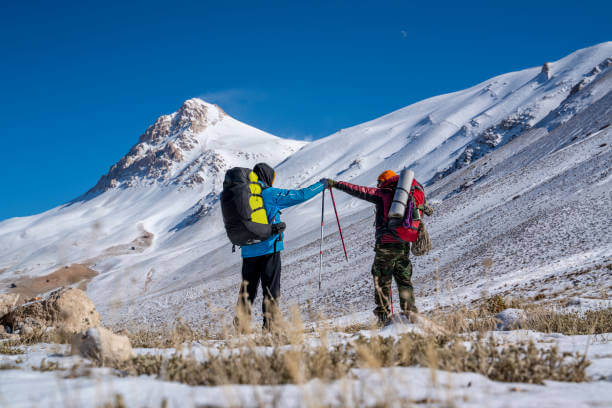Mountaineering camp is a multifaceted pursuit that combines physical challenges, mental resilience, and a deep connection with nature. Whether you are a seasoned mountaineer or a novice looking to embark on your first alpine adventure, understanding the essential aspects of mountaineering camp is crucial. This comprehensive guide provides insights into mountaineering camps, essential gear, physical and mental preparation, safety measures, choosing the right camp, environmental considerations, and exploring mountaineering destinations.
Table of Contents
What Sets Mountaineering Camps Apart?
Mountaineering camps aren’t just about reaching summits; they’re about self-discovery, teamwork, and pushing your limits. Here’s why they stand out:
- Immersive Learning Experience: Gain hands-on knowledge about survival skills, navigation, and understanding the mountain ecosystem.
- Team Bonding: Forge unbreakable bonds with your fellow climbers as you conquer challenges together.
Understanding Mountaineering
Mountaineering, also known as alpinism, encompasses a range of outdoor activities involving ascending mountains. It involves traditional outdoor climbing, skiing, and peak bagging. Traditional mountaineering focuses on identifying specific mountains and routes, often culminating in reaching the summit. This activity is associated with aid climbing, free climbing, and the use of ice axe and crampons on glaciers and similar terrain.
The Allure of Mountaineering Camps
Mountaineering camps provide a unique opportunity for individuals to immerse themselves in the world of mountaineering. These camps offer hands-on training in essential mountaineering skills, such as ice axe and crampon use, self-arrest, and backcountry camping. Participants have the chance to practice these skills in the field, including glacier crossings, peak ascents, and route-finding challenges. Mountaineering camps are an opportunity for club members to come together in a beautiful location and climb or scramble up peaks, fostering a sense of community and adventure.
Essential Gear for Mountaineering Camps
Clothing
- Layering for warmth and protection
- Understanding the importance of layering in mountain environments to stay warm and protected from the elements
- Utilizing waterproof and breathable materials to maintain comfort and safety
Footwear
- Boots for different terrains
- Selecting appropriate boots for various terrains, considering factors such as ankle support and insulation
- Understanding the importance of socks and gaiters in maintaining foot health and comfort during mountaineering activities
Equipment
- Harnesses, ropes, and carabiners
- Exploring the essential equipment required for safety and security during mountaineering
- Understanding the use of harnesses, ropes, and carabiners in different mountaineering scenarios
- Helmets and ice axes
- Recognizing the significance of helmets and ice axes in protecting against falls and navigating challenging terrain
- Learning the proper techniques for using ice axes in snow and ice climbing
Physical and Mental Preparation
Cardiovascular Fitness
- Importance of endurance training
- Recognizing the critical role of endurance training in preparing for the physical demands of mountaineering
- Engaging in recommended exercises to build cardiovascular strength and stamina
Strength and Flexibility
- Training for upper and lower body strength
- Implementing training regimens to develop the necessary strength for mountaineering activities
- Exploring exercises for enhancing upper and lower body strength
- Stretching and yoga for flexibility
- Emphasizing the importance of flexibility in preventing injuries and improving overall performance
- Incorporating stretching and yoga routines to enhance flexibility and mobility
Understanding the Risks
- Navigating unpredictable weather
- Developing an awareness of the challenges posed by unpredictable weather conditions in mountain environments
- Learning strategies for mitigating risks associated with changing weather patterns
- Coping with altitude challenges
- Understanding the physiological and psychological effects of high altitudes on the human body
- Implementing techniques for acclimatization and managing altitude-related challenges
Developing Mental Resilience
- Stress management techniques
- Exploring effective stress management strategies for coping with the mental and emotional demands of mountaineering
- Learning to maintain composure and focus in high-pressure situations
- Building confidence and decision-making skills
- Enhancing decision-making abilities and confidence in navigating challenging and potentially hazardous situations
- Cultivating mental resilience and adaptability in the face of adversity
Safety Measures
Understanding Avalanche Safety
- Recognizing avalanche terrain
- Identifying the characteristics of avalanche-prone terrain and understanding the associated risks
- Implementing strategies for navigating avalanche terrain safely
- Carrying essential avalanche gear
- Understanding the importance of carrying avalanche safety equipment, such as beacons, shovels, and probes
- Practicing the proper use of avalanche gear in simulated scenarios
First Aid Training
- Dealing with common mountaineering injuries
- Recognizing common injuries and medical emergencies encountered in mountaineering
- Learning essential first aid techniques for treating injuries in remote and challenging environments
- Administering emergency care in remote locations
- Understanding the unique challenges of providing emergency care in remote and wilderness settings
- Developing the skills and knowledge necessary to administer effective emergency care in mountaineering contexts
Choosing the Right Camp
Researching Camp Options
- Factors to consider when selecting a camp
- Evaluating factors such as location, facilities, and the expertise of instructors when choosing a mountaineering camp
- Considering the specific skills and experiences offered by different camps
- Reading reviews and testimonials
- Utilizing reviews and testimonials from previous participants to gain insights into the quality and reputation of mountaineering camps
- Making informed decisions based on the experiences of others
Evaluating the Camp’s Itinerary
- Assessing the difficulty level
- Understanding the importance of matching the difficulty level of the camp with individual skill and experience levels
- Ensuring that the camp’s challenges align with personal goals and aspirations
- Ensuring a well-rounded experience
- Seeking camps that offer a comprehensive and diverse itinerary, encompassing various aspects of mountaineering
- Ensuring that the camp provides a balanced and enriching experience for participants
Best place to visit Mountaineering?
Exploring Mountaineering Destinations
- Understanding the appeal of different mountaineering destinations
- Exploring the diverse landscapes and challenges offered by various mountain ranges
- Considering factors such as accessibility, difficulty levels, and cultural experiences in different regions
Popular Mountaineering Locations
- The allure of the Himalayas
- Discovering the majestic peaks and challenging terrain of the Himalayan mountain range
- Exploring the cultural and spiritual significance of mountaineering in the Himalayas
- The beauty of the Alps
- Understanding the allure of the iconic Alpine peaks and their rich mountaineering history
- Exploring the diverse mountaineering opportunities offered by the Alps, from traditional climbing to ski mountaineering
- North American mountaineering experiences
- Discovering the rugged beauty of the Rocky Mountains and the challenges they present to mountaineers
- Exploring the unique opportunities for mountaineering in North America, from peak bagging to enchainment
Mountaineering Courses and Programs
- Beginner mountaineering courses
- Exploring introductory mountaineering courses designed for individuals new to the sport
- Understanding the skills and experiences offered by beginner mountaineering programs
- High-altitude expedition opportunities
- Discovering mountaineering expeditions that offer the challenge of high-altitude climbing
- Exploring the prerequisites and experiences required for high-altitude mountaineering expeditions
Considerations for Mountaineering Destinations
- Accessibility and logistics
- Understanding the logistical considerations for accessing and navigating mountaineering destinations
- Exploring transportation, accommodation, and support services available in different locations
- Cultural and environmental impact
- Considering the cultural and environmental implications of mountaineering in specific destinations
- Exploring responsible and sustainable practices when engaging in mountaineering activities in diverse locations
Environmental Considerations
Leave No Trace Principles
- Minimizing impact on the environment
- Emphasizing the importance of responsible and sustainable practices in natural environments
- Implementing Leave No Trace principles to minimize ecological impact during mountaineering activities
- Responsible waste management
- Understanding the significance of proper waste disposal and management in wilderness areas
- Practicing responsible waste management to preserve the natural beauty of mountain environments
Wildlife Awareness
- Understanding local wildlife
- Gaining knowledge of the native flora and fauna in the areas where mountaineering activities take place
- Respecting and appreciating the natural habitats and ecosystems encountered during mountaineering expeditions
- Coexisting with nature in the camp environment
- Learning to coexist harmoniously with wildlife and natural surroundings during mountaineering camps
- Adopting practices that minimize disturbances to local wildlife and ecosystems
Conclusion
Mountaineering camps offer a transformative experience, fostering personal growth, resilience, and a deep connection with nature. They provide an opportunity for individuals to challenge themselves, learn essential skills, and embark on a journey of self-discovery amidst breathtaking natural landscapes. The allure of mountaineering camps lies in the unique blend of adventure, education, and camaraderie, making them an ideal platform for individuals to explore the boundless possibilities of mountaineering. Whether scaling the peaks of the Himalayas, navigating the challenges of the Alps, or embarking on high-altitude expeditions, the world of mountaineering beckons with its promise of adventure and self-discovery.
Frequently Asked Questions (FAQs)
- Q: Is mountaineering suitable for beginners?
- A: Absolutely! Many camps cater to varying skill levels, providing a safe environment for beginners.
- Q: What fitness level is required for mountaineering?
- A: While a basic level of fitness is essential, specific camps cater to different fitness levels.
- Q: Are mountaineering camps only for the adventurous?
- A: Mountaineering camps cater to a spectrum of individuals, from thrill-seekers to nature enthusiasts.
- Q: How do I choose the right camp for me?
- A: Consider factors like location, difficulty level, and the overall experience offered by the camp.
- Q: Is mountaineering gear expensive?
- A: While quality gear can be an investment, many camps offer rental options for participants.
- Q: Are mountaineering camps safe?
- A: Reputable camps prioritize safety, with trained guides and strict adherence to safety protocols.
- Q: Can families participate in mountaineering camps?
- A: Some camps are family-friendly, offering a unique bonding experience in the mountains.
- Q: What should I do if I encounter wildlife during a climb?
- A: Stay calm, avoid sudden movements, and follow the guidance of your experienced guides.




